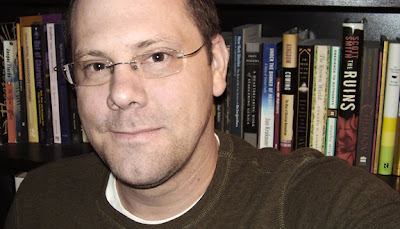 David Cote
David CoteWorkwise, constant theatergoing and writing – that’s my job. I edit the theater section of Time Out New York (TONY), assigning reviewers and reporters and trying to review two or three shows a week myself. What I can’t fit into the Lilliputian space our magazine allots for reviews (approx. 280 words) I dilate upon in my blog.
But if you ask what the fuck is going on in NYC theater? Not enough! That is to say, our major nonprofit companies, in my opinion, are spinning their wheels aesthetically. Season after season, the programming is safe, conventional and blandly marketed to a public that doesn’t care anyway. Where’s the political theater? Where are the professional productions that exciting “downtown” playwrights deserve? Where are the plays that might (gasp) offend viewers or get them talking?
the politcal
theater?”
Where are the artistic directors with charisma, media savvy, showmanship, imagination, chutzpah, vision and connections, who will create amazing seasons of established and emerging artists, who will attract media attention, get people buzzing? I’m almost less worried about nurturing the next generation of writers, directors and actors than in the administrators and marketing folks whose job it is to sell this stuff to the New York public.
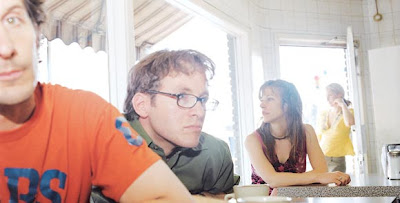 Bluemouth Inc. (L-R): Stephen O’Connell, Richard Windeyer, Lucy Simic, Sabrina Reeves.
Bluemouth Inc. (L-R): Stephen O’Connell, Richard Windeyer, Lucy Simic, Sabrina Reeves. 2) Is avant-garde, boundary-pushing art somehow fundamentally more worthy than art that reinforces or sustains the status quo?
To quote Bjork, “we are theatrical scientists.” It’s really not an issue of more or less. We do what makes us happy – looking at unique ways of perceiving performance is what keeps bringing us back to the process.
It’s all so relative anyhow. Whatever we may think is boundary-pushing may be tame in comparison to most of the performance art I’ve seen. How about the French performance artist Orlan, who has undergone numerous plastic surgeries to transform her face and body to challenge traditional perceptions of beauty? Now that’s commitment.
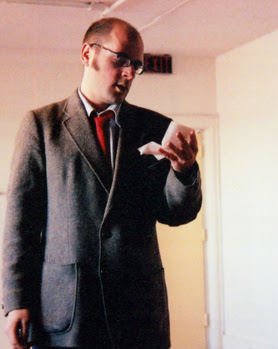 Jacob Zimmer
Jacob Zimmer
I wish we talked more about the “why” questions. Not in the rehearsal hall, but between artists (and in public). Why certain choices get made, why one makes theatre, why this staging over another, why work in a certain way . . . They’re hard questions and we avoid them because, I think, they would lead to disagreement and out of some fear that articulating them could be dangerous to inspiration (over-analyzing). But I think they’re very important as we continue forward and wish we could find a way to talk about it. To talk about the ethics/values of our work.
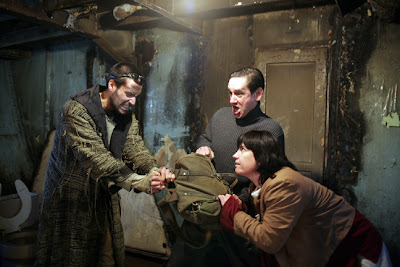 L-R: Dusan Dukic, Martin Julien and Dragana Varagic.
L-R: Dusan Dukic, Martin Julien and Dragana Varagic.Photo by Cylla Tiedemann.
4) What do you know now that you wish you knew when you were younger?
That most people in Canada don’t really care about theatre that much. There’s really not much of a sustaining industry. This includes the media. Not too much happens, in the end. If I’d known that, I wouldn’t have wasted so much time and emotional effort trying to “build a career.” I would’ve just got on with the work, knowing it was a rarefied interest with its own rewards.
And, oh yes – don’t waste time trying to impress people. Sigh. Young people are always trying to make an impression.
5) How has the Fringe of Toronto Theatre Festival changed since you started working with it?
Definitely more artists are aware of what a useful and affordable development tool the Fringe is. Each year the number of applications we receive grows. This past year we received 550 applications to the Fringe lottery and the ongoing joke in the office was that your odds were better to win $1,000,000 in the Heart & Stroke Lottery than they were to secure a spot in the Fringe.
High-profile success such as The Drowsy Chaperone, JOB: The Hip-Hopera and da kink in my hair have also introduced the Toronto Fringe and the Fringe philosophy to a wider audience and can help explain the huge increases in applications from artists across Canada and around the world.
Here at home, local artists are finding it more expensive to develop work, hence applications from local companies have also skyrocketed as artists look to take advantage of the affordable and supportive environment the Fringe provides for these artists to create.
Also, since I started working for the Fringe I’ve personally made it a point to promote and celebrate the fact that the Fringe remains unjuried and that we return 100% of the ticket price back to the artists. It’s not uncommon to see us referring to ourselves as “Toronto’s Theatre Festival” (since we remain accessible to a much larger cross section of the population) and how we’re “unjuried, unexpected, unforgettable” on all of our marketing material. I think people have responded extremely well to these statements and to what the Fringe is all about.
Over the past seven years we’ve continued to set records in both attendance and in box office revenue and hope to sell over 50,000 tickets this July.
6) Do you think class barriers are preventing theatre from being a more vital part of Canadian culture?
Yes, it’s still seen as an elitist artform in many cases, aside from the fact that you can see great theatre for the same price or less than a movie. And, in fact, even most of the larger companies offer great rush or student discounts – but no one knows about them!
Outside the theatre community, theatre is often seen as stuffy and strange. I think archaic marketing and protocol contributes to deterring new and younger potential theatregoers (namely the 18-40 demographic). They don’t read papers, which is our traditional theatre advertising medium, and it’s not easy to get to or find out about.
I also think allowing food and beverages in theatres would help matters. I know we’re not all set up for cabaret and actors would have to put up with munching and crackling, but who cares! If it gets more bums in seats (and generates more money off liquor sales for theatres), then why not! There should also be connected afterparties and events to hook people in. Create a more social environment and event and I think we’ll draw a much wider and more interested crowd.
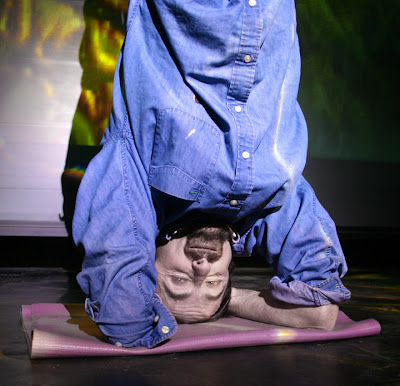 Simon Michellepis
Simon Michellepis- Better shows. Ultimately, it’s our job to invent a better mousetrap and meet the needs of our audience.
- Better management (by the varied theatre institutions [media, grant, CAEA, etc]): Leadership must come from those who have influence. In the face of the challenges that have faced Toronto theatre over the past four years, I am surprised and saddened by what I see as a fundamental lack of leadership response.
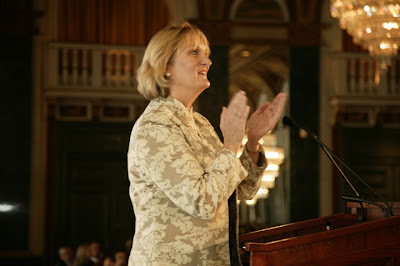 Claire Hopkinson
Claire Hopkinson
I am in a painful quandary. In comparison with all the major cities in North America, Toronto has the lowest municipal arts funding rate. Toronto’s per capita contributions to arts, culture and heritage (including both operating and capital expenditures) is $14.64. Compare this to Vancouver at $17.71, Chicago at $21.95, Montreal at $26.62 and San Francisco at $86.01. Toronto’s municipal funding is not sufficient for a city that is home to so many talented people, a city that is a hotbed of creativity, a city whose value-proposition truly is arts and culture!
This is not to say that the arts are not valued here. We have champions at City Hall, and our current Mayor is certainly arts-friendly. If you read the newspapers these days, you’ll know that the City is in a terrible financial straight jacket. Years of downloading from the Province plus a Federal government that seems unwilling to invest in Toronto, are taking their toll.
My question is, what can we as citizens, as artists, as people who care about this city do about it? If you are not yet a member of Toronto Arts Coalition, this is a internet-based group of arts supporters and a forum for communication with politicians. It is free and you can join by going to www.torontoartscoalition.org.
Now that is truly a question for Ronnie Burkett! I do have a few thoughts. One of the many things theatre offers is the doorway to another world – a fantasy. Many times on a stage that is created through set, makeup and lights. When I worked in black light puppetry, we didn’t have those things so the puppets themselves, their uniqueness, their fantastical nature in being creations of the mind – everything from ordinary cats to creatures from another planet – were what created that fantasy world. I also think puppets are important because they are like living cartoons and the animated world is something that appeals to all generations young and old.
10) If class issues are preventing theatre from being a more vital voice in American culture, who’s responsible and how do we fix it?
I think class is, to appropriate Pinter, the weasel under the cocktail cabinet. Nobody wants to talk about the fact that 80% of the theatre audience is drawn from the top 15% of America’s economic class. Thus, government support of the arts looks like another handout for the rich.
As Dudley Cocke, artistic director of Roadside Theatre in Whitesburg KY says, “the assembled spectators for the typical not-for-profit professional theater production don’t look like any community in the U.S., except, perhaps, a gated one. From such a narrow social base, great democratic art will never rise.” I agree.
Who’s responsible? Tyrone Guthrie. He hijacked the regional theatre movement and made it a haven for the wealthy, educated class who would put up with museum pieces in order to appear “cultured.”
How do we fix it? First, decentralize theatre – get over our childish fixation with the Cinderella story of NYC and perform in towns across America. Second, think outside the box – by which I mean, think outside the theatre building. Do theatre in living rooms, back yards, community centers, bars, parks. Third, learn to speak the language. Different cultures and classes tell stories differently – go to them, don’t expect them to come to you.
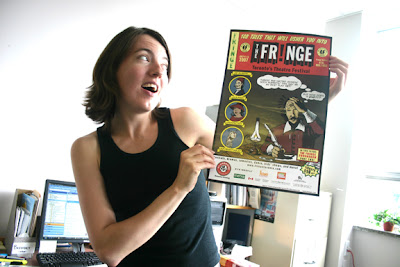

Thanks for including me. The list starts with David Cote and ends with me! Thank God Melissa-Jane Shaw is between us!
Funny!
I always knew you were a bottom, Scott! Oh, snap.